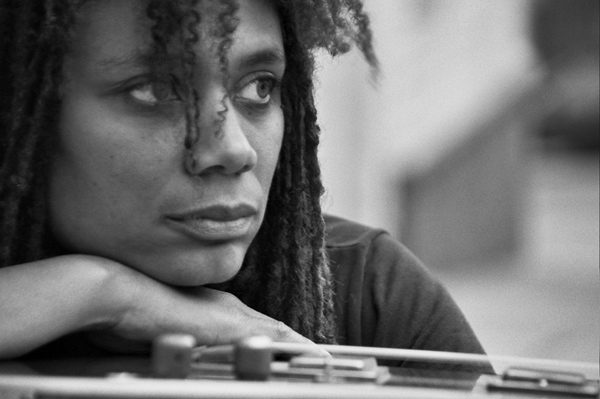Shelley Doty on inspiration, animation and her new film Strange Frame.
The genre of science fiction has always attracted lesbians in one way or another. Maybe it’s the smart, sexy women clad in skintight uniforms or perhaps because it offers an alternative view of the world where gender equality was possible, far before is time.
Strange Frame: Love and Sax, a groundbreaking full-length animated sci-fi lesbian musical created by out musician Shelley Doty and director G.B. Hajim has earned stellar reviews and was even awarded the Best Feature Film at Dragon*Con in 2012.
Strange Frame is set in the 28th century on Ganymede, a moon of Jupiter, where humans, who long since evacuated Earth have modified themselves to the point of making skin color and sex organs into fashion statements. The story revolves around two musicians, Parker and Naia, and their struggle to keep their careers and relationship afloat. Fate and fame intervene and both women are forced to test themselves and each other. The result is a dreamlike tale that is thought provoking and utterly unforgettable.
Tell us a bit about the birth of Strange Frame.
Strange Frame is the culmination of years of imaginative collaboration between myself and my co-creator GB Hajim. GB and I went to college together, and have been dear friends for a few decades now. We share a love of science fiction, and we both think that at its best can be described as “social fiction”—take a concept, like say: What if humans could read minds? Then use that conceit to explore how people communicate and interact. I think that many people who aren’t into science fiction don’t always realize that it can be an amazing path to tell stories about who we are by using the suspension of disbelief and loosening the concepts of reality to really dig into particular aspects of the human condition. Plus, you can get some cracking good stories out of it! This is what has always drawn me to sci-fi books and short stories in particular.
Back in the early ’90s, my wife and I were visiting GB and his family at their house on the big island of Hawaii. GB and I were pretty much driving our wives crazy by riffing on some of our favorite books and anime series, when we decided that we should just write our own animated TV series. After many years of writing scripts and music and applying for grants for a TV version of our unique universe, we decided that trying to fit into the corporate culture of any TV production house was going to be too limiting, and shifted our energy to independently making a series of feature length films. Strange Frame is the first of these movies, and functions as a prequel to the original television concept. GB and I co-wrote the script, he formed an animation production house from scratch and started designing and animating and I got to work writing music.
Did you set out to make the first full-length animated sci-fi lesbian musical?
In a way, I suppose we did. We were striving to create a universe that would appeal to and serve queer youth of color. Many years ago, I was tremendously inspired by the book, and movie, The Celluloid Closet. It articulated so strongly what I was feeling as a young black lesbian growing up with so very little reflection of my own reality back at me in popular media. Strange Frame went through a lot of developmental phases, but at the heart of it was the concept of our very rich universe, and some of the base elements that we were determined to inject into our universe were: Who you love is not an issue, gender is self assignable, and pretty much everyone is some shade of brown. We knew we wanted a lesbian couple as our heroes, and we knew they wouldn’t be white. Our universe was no utopia however, not in the least. We delve deeply into social dynamic politics, notions of extreme class differentiation, debt slavery, revolution and the destruction of Earth as a viable living environment.

Have you always been a fan of animated films?
Absolutely! As a kid I was firmly in the generation of Saturday morning cartoons and I certainly loved them, but when I discovered Japanese animation as a teenager all bets were off. I saw my first Miyazaki movie—Nausicaa of the Valley of the Wind—at a film festival and the mastery of his storytelling, and the integration of incredible visuals and the majestic soundtrack by Joe Hisaishi just blew me away. In the last 10 years or so, the availability of Japanese Anime and Manga in the U.S. has exploded, but when GB and I first started kicking around ideas for Strange Frame that hadn't quite happened yet—but somehow both of us had managed to watch and fall in love with Cowboy Bebop—a major Strange Frame influence in many ways.
Strange Frame has received rave reviews from festivals and the community. Were you surprised by the response?
I think we reckoned that some people would love it, and some people would walk away scratching their heads. This is not a mainstream movie. GB’s animation style is very unique, and looks like nothing else out there. Some folks see the visual style and fall deeply in love, and some folks don’t. We know that it is a dense film conceptually and plot wise, and definitely benefits from multiple viewings. I think we both expected that if we make the film that made us happy, just let it follow its own freaky path, then there would be folks out there who would appreciate and hopefully love it. So far, that has been the case, and it has been tremendously gratifying when new viewers get the film.
